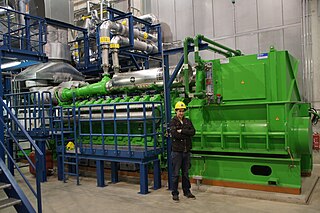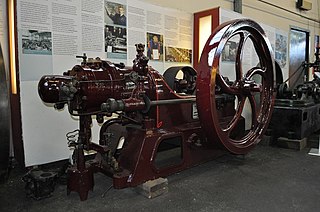 W
WA stationary engine is an engine whose framework does not move. They are used to drive immobile equipment, such as pumps, generators, mills or factory machinery, or cable cars. The term usually refers to large immobile reciprocating engines, principally stationary steam engines and, to some extent, stationary internal combustion engines. Other large immobile power sources, such as steam turbines, gas turbines, and large electric motors, are categorized separately.
 W
WA gas engine is an internal combustion engine that runs on a gaseous fuel, such as coal gas, producer gas, biogas, landfill gas or natural gas. In the United Kingdom, the term is unambiguous. In the United States, due to the widespread use of "gas" as an abbreviation for gasoline (petrol), such an engine might also be called a gaseous-fueled engine or natural gas engine or spark ignited.
 W
WA hit-and-miss engine or Hit 'N' Miss is a type of internal combustion engine that is controlled by a governor to only fire at a set speed. They are usually 4-stroke but 2-stroke versions were made. It was conceived in the late 19th century and produced by various companies from the 1890s through approximately the 1940s. The name comes from the speed control on these engines: they fire ("hit") only when operating at or below a set speed, and cycle without firing ("miss") when they exceed their set speed. This is as compared to the "throttle governed" method of speed control. The sound made when the engine is running without a load is a distinctive "Snort POP whoosh whoosh whoosh whoosh snort POP" as the engine fires and then coasts until the speed decreases and it fires again to maintain its average speed. The snorting is caused by the atmospheric intake valve used on many of these engines.
 W
WHopper cooling is a simple form of water cooling used for small stationary engines. The defining feature of hopper cooling, amongst other water-cooled engines, is that there is no radiator. Cooling water is heated by the engine and evaporates from the surface of the hopper as steam.
 W
WThe Hornsby-Akroyd oil engine, named after its inventor Herbert Akroyd Stuart and the manufacturer Richard Hornsby & Sons, was the first successful design of an internal combustion engine using heavy oil as a fuel. It was the first to use a separate vapourising combustion chamber and is the forerunner of all hot-bulb engines, which are considered predecessors of the similar Diesel engine, developed a few years later.
 W
WThe Lister D is a 1.5 - 2.5hp stationary engine on petrol or petrol/paraffin (fuel) built between 1926-1965 by R A Lister and Company of Dursley. It is popular with newcomers to the stationary engine hobby with un-restored examples available for as little as £100, plenty of spares and various re-manufactured parts and decals. It replaced the Lister H, which was of a similar output. The first Lister D engine serial number 80,000 was assembled on the 26th October, 1926.
 W
WThe Otto engine was a large stationary single-cylinder internal combustion four-stroke engine designed by the German Nicolaus Otto. It was a low-RPM machine, and only fired every other stroke due to the Otto cycle, also designed by Otto.
 W
WStationary steam engines are fixed steam engines used for pumping or driving mills and factories, and for power generation. They are distinct from locomotive engines used on railways, traction engines for heavy steam haulage on roads, steam cars, agricultural engines used for ploughing or threshing, marine engines, and the steam turbines used as the mechanism of power generation for most nuclear power plants.
 W
WHerbert Akroyd-Stuart was an English inventor who is noted for his invention of the hot bulb engine, or heavy oil engine.
 W
WThe hot-bulb engine is a type of internal combustion engine in which fuel ignites by coming in contact with a red-hot metal surface inside a bulb, followed by the introduction of air (oxygen) compressed into the hot-bulb chamber by the rising piston. There is some ignition when the fuel is introduced, but it quickly uses up the available oxygen in the bulb. Vigorous ignition takes place only when sufficient oxygen is supplied to the hot-bulb chamber on the compression stroke of the engine.
 W
WA winding engine is a stationary engine used to control a cable, for example to power a mining hoist at a pit head. Electric hoist controllers have replaced proper winding engines in modern mining, but use electric motors that are also traditionally referred to as winding engines.